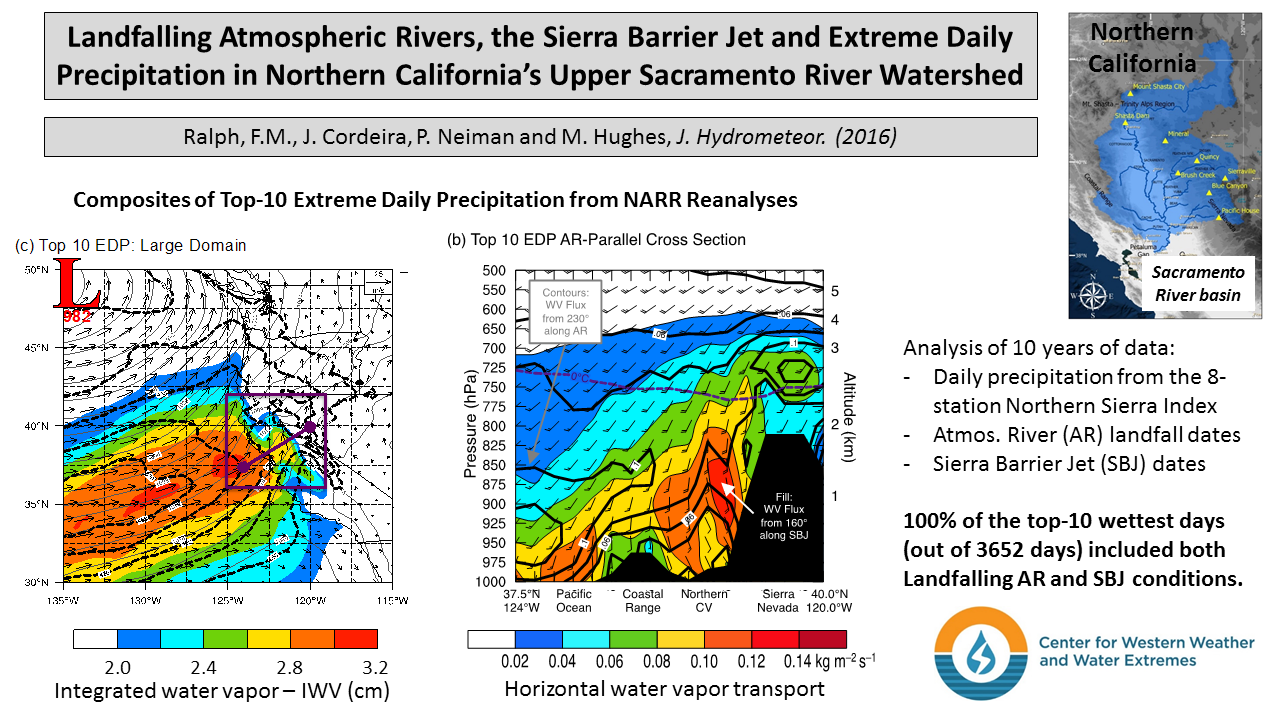CW3E Publication Notice
Extreme Daily Precipitation in the Northern California Upper Sacramento River Watershed Requires a Combination of a Landfalling Atmospheric River and a Sierra Barrier Jet
July 18, 2016
Ralph, F.M., J.M. Cordeira, P.J. Neiman and M. Hughes, 2016: Extreme Daily Precipitation in the Northern California Upper Sacramento River Watershed Requires a Combination of a Landfalling Atmospheric River and a Sierra Barrier Jet. J. Hydrometeor., 17, 1904-1915.
The top 0.3% most extreme daily precipitation events in the key Sacramento River watershed all involved both a landfalling atmospheric river and a Sierra Barrier Jet. Thus, forecasts of extreme precipitation are related to the skill of forecasts of each of these key phenomena, and can be enhanced by evaluation of, and enhancement of, skill in predicting each of these key processes. This study was led by the CW3E Director, was supported by the California Department of Water Resources, used data from NOAA’s Hydrometeorology Testbed collected over a decade, and epitomizes the focus of the “Center for Western Weather and Water Extremes,” and its partnership with NOAA Research’s Physical Sciences Division and Plymouth State University.
Contact: F. Martin Ralph (mralph@ucsd.edu)
Abstract
The upper Sacramento River watershed is vital to California’s water supply and is susceptible to major floods. Orographic precipitation in this complex terrain involves both atmospheric rivers (ARs) and the Sierra barrier jet (SBJ). The south-southeasterly SBJ induces orographic precipitation along south-facing slopes in the Mt. Shasta–Trinity Alps, whereas landfalling ARs ascend up and over the statically stable SBJ and induce orographic precipitation along west-facing slopes in the northern Sierra Nevada. This paper explores the occurrence of extreme daily precipitation (EDP) in this region in association with landfalling ARs and the SBJ. The 50 wettest days (i.e., days with EDP) for water years (WYs) 2002–11 based on the average of daily precipitation from eight rain gauges known as the Northern Sierra 8-Station Index (NS8I) are compared to dates from an SSM/I satellite-based landfalling AR-detection method and dates with SBJ events identified from nearby wind profiler data. These 50 days with EDP accounted for 20% of all precipitation during the 10-WY period, or 5 days with EDP per year on average account for one-fifth of WY precipitation. In summary, 46 of 50 (92%) days with EDP are associated with landfalling ARs on either the day before or the day of precipitation, whereas 45 of 50 (90%) days with EDP are associated with SBJ conditions on the day of EDP. Forty-one of 50 (82%) days with EDP are associated with both a landfalling AR and an SBJ. The top 10 days with EDP were all associated with both a landfalling AR and an SBJ.

